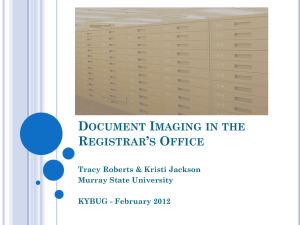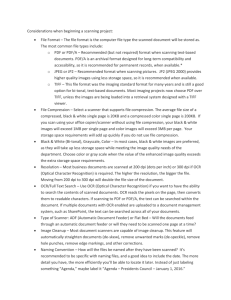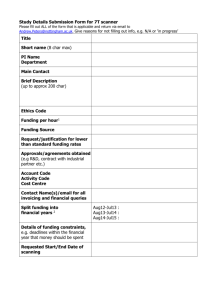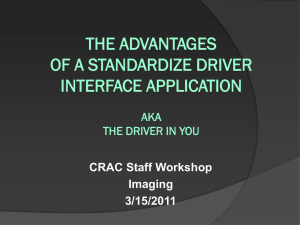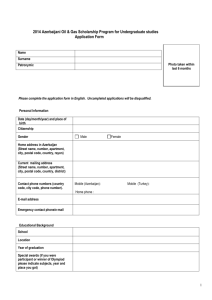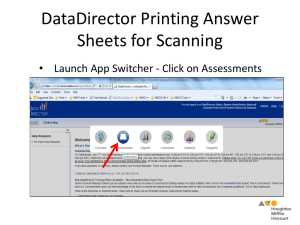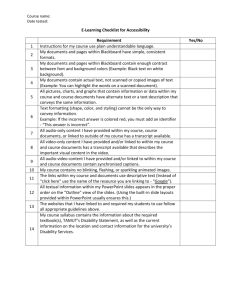hybrid methodology for automated collection of data from
advertisement
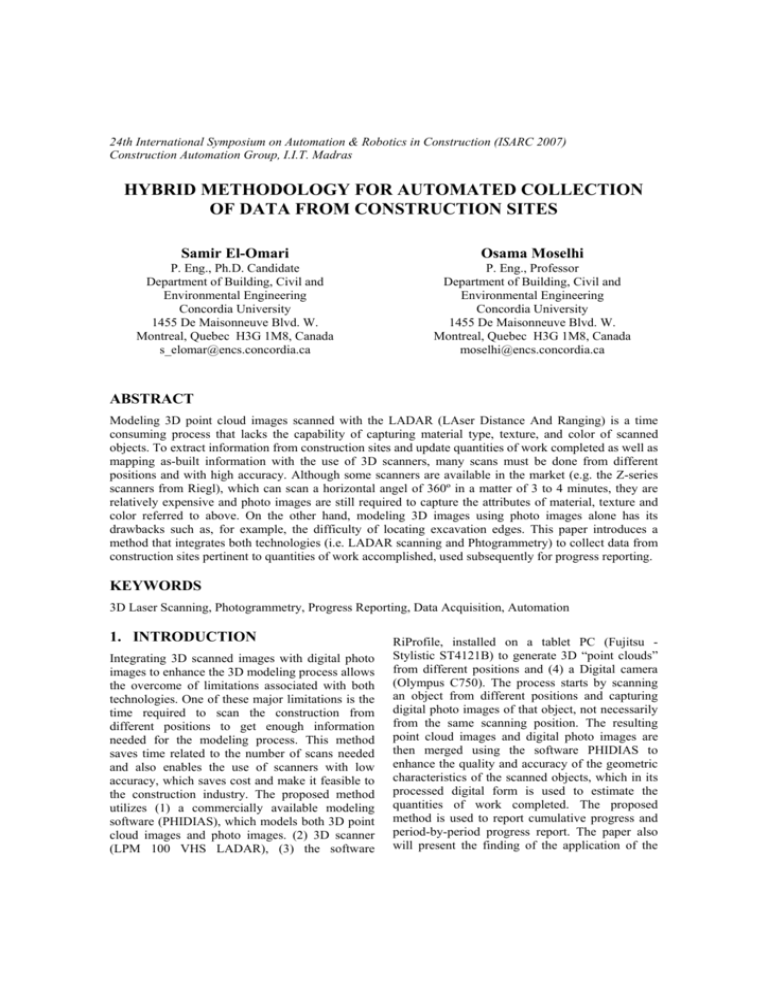
24th International 24th InternationalSymposium Symposiumon onAutomation Automation&&Robotics RoboticsininConstruction Construction(ISARC (ISARC2007) 2007) Madras Construction Automation Group, I.I.T. Madras HYBRID METHODOLOGY FOR AUTOMATED COLLECTION OF DATA FROM CONSTRUCTION SITES Samir El-Omari Osama Moselhi P. Eng., Ph.D. Candidate Department of Building, Civil and Environmental Engineering Concordia University 1455 De Maisonneuve Blvd. W. Montreal, Quebec H3G 1M8, Canada s_elomar@encs.concordia.ca P. Eng., Professor Department of Building, Civil and Environmental Engineering Concordia University 1455 De Maisonneuve Blvd. W. Montreal, Quebec H3G 1M8, Canada moselhi@encs.concordia.ca ABSTRACT Modeling 3D point cloud images scanned with the LADAR (LAser Distance And Ranging) is a time consuming process that lacks the capability of capturing material type, texture, and color of scanned objects. To extract information from construction sites and update quantities of work completed as well as mapping as-built information with the use of 3D scanners, many scans must be done from different positions and with high accuracy. Although some scanners are available in the market (e.g. the Z-series scanners from Riegl), which can scan a horizontal angel of 360º in a matter of 3 to 4 minutes, they are relatively expensive and photo images are still required to capture the attributes of material, texture and color referred to above. On the other hand, modeling 3D images using photo images alone has its drawbacks such as, for example, the difficulty of locating excavation edges. This paper introduces a method that integrates both technologies (i.e. LADAR scanning and Phtogrammetry) to collect data from construction sites pertinent to quantities of work accomplished, used subsequently for progress reporting. KEYWORDS 3D Laser Scanning, Photogrammetry, Progress Reporting, Data Acquisition, Automation 1. INTRODUCTION Integrating 3D scanned images with digital photo images to enhance the 3D modeling process allows the overcome of limitations associated with both technologies. One of these major limitations is the time required to scan the construction from different positions to get enough information needed for the modeling process. This method saves time related to the number of scans needed and also enables the use of scanners with low accuracy, which saves cost and make it feasible to the construction industry. The proposed method utilizes (1) a commercially available modeling software (PHIDIAS), which models both 3D point cloud images and photo images. (2) 3D scanner (LPM 100 VHS LADAR), (3) the software RiProfile, installed on a tablet PC (Fujitsu Stylistic ST4121B) to generate 3D “point clouds” from different positions and (4) a Digital camera (Olympus C750). The process starts by scanning an object from different positions and capturing digital photo images of that object, not necessarily from the same scanning position. The resulting point cloud images and digital photo images are then merged using the software PHIDIAS to enhance the quality and accuracy of the geometric characteristics of the scanned objects, which in its processed digital form is used to estimate the quantities of work completed. The proposed method is used to report cumulative progress and period-by-period progress report. The paper also will present the finding of the application of the S. El-Omari & O. Moselhi 94 proposed method on an actual currently under construction project in the Montreal area. Advantages and limitations of the 3D scanning and Photogrammetry are highlighted. 2. LADAR LADAR scanning is the process collecting 3D points or “point clouds” that are later processed using software packages, to transform these points into 3-D objects to be used subsequently in calculating quantities of work completed on site. The data points are given in x, y, z, coordinates. The LADAR technology works by sending illumination pulse to an object and receiving it back. The distance between the object and the LADAR station is called the “Range”. The laser beam traverses a distance equal to 2d [1]. The time needed to accomplish this operation can be expressed by Equation 1 below. T = 2d/c Figure 1 Site Scanning (1) Where “c” is the speed of light, “d” is known as the “Range” and is defined as the distance between the object and the LADAR, and “T” is the travel time. It was reported that a clock time of 1ns (nano second) represents a 300 mm round-trip or an absolute range “d” of 150 mm (Stone et al. 2002). Every pulse will produce a pixel or a point in a point cloud that represent a range image. At the early stages of the current research some test scans were performed to identify the scanner accuracy. The modeling software package POLYWORKS was used to process scanned images [2], [3]. The scanning activities were performed with the Riegl LPM 100 VHS LADAR scanner. Figure 1 illustrates the scanner while connected to the tablet PC (Fujitsu - Stylistic ST4121B) via a serial cable during the scanning process. After creating a new project on RiProfile, the rage angels must be set with the help of the scanner configuration window (Figure 2). The horizontal and vertical range angles are set to identify the image need to be scanned. The resolution of the scan can be affected by the resolution angle. This angle together with the distance from the object to the scanner specifies the distance between each point in space. The angle is also known as the angle of incidence [1]. Figure 2 Scanner Configuration 3. SITE SCAN The new building of Concordia for the business department was considered for test scans. The construction site is 60 m x 40 m and scans were performed along the longer side. The purpose of the scan is to model scanned images and estimate quantities of work performed at the end of working day. The time of a single scan depends on the vertical and horizontal resolution angles and for a construction site of that size it was necessary to scan it with a wide horizontal angle of about 200° and vertical range angle of 59°. The vertical and horizontal resolutions were set then equal to 0.2°. The time required to scan this range were found to be about 26’ 36” and the number of points in the point cloud image were 295,295. The second factor that affects the resolution next to the resolution angle is the distance of the scanner to the scanned object and as the site was scanned form its long side, that distance varied from 1 m to about 50 with an average of 30 m. If we consider the 30 m then the distance between two adjacent Hybrid Methodology for Automated Collection of Data from Construction Sites points of the point cloud image with a resolution angle of 0.2° would be about 10cm. This of course is considered low accurate and if the resolution angle have to be decreased to give a distance of about 5 mm between the points then it must be 0.01°. The horizontal resolution angle was set to 0.01° while the scanner automatically set the vertical to 0.027°. The result of these configurations was as follows. Time required for scanning the same horizontal and vertical range angle but with enhanced resolution angle approached the 50 hours with a number of points in the point cloud image of 42,690,956. Knowing that scans must be at the end of working day and few scans must be performed it was impossible to set the scanner configurations to such data. Despite the fact that there exist scanners, which can take much faster time to scan the same image like the Z-series from Riegel [3] it was clear that even after scanning with higher resolution the scanned image will lack information pertinent to texture and color of the scanned object and additionally, many scans can not be avoided to get enough information and consequently, a photo image must be available to help in 3D modeling of the scanned image. Another observation were found when working with the LPM 100 VHS LADAR is when decreasing the resolution angle the point cloud image would be very congested and not on the same level. Figure 3 Front View of Scanned Lab Door Figure 3 is the result of a scanned door lab with a horizontal resolution angle of 0.015° and Figure 4 depicts the horizontal cross section of that door. As 95 shown in that figure, the points are not on the same plane, which makes it difficult to get the door dimensions. Figure 4 Horizontal Cross Section in the Lab Door 4. 3D SCANNING AND DIGITAL PHOTO IMAGES The main limitation lies with the LADAR is the time required to scan an object from different positions to get enough information regarding its geometrical properties. To overcome this limitation the authors thought of integrating digital photo images with the scanned image. Digital images provide detailed information pertinent to object color and texture. It remains time consuming to model 3D images from only digital images. The reason for that is the time required to position many targets with known coordinates that assists in the modeling process. Figure 5 Targets Placement for 3D Modeling from Photo Images As illustrated in Figure 5, targets must be placed in the image to be able to identify the coordinates of the different objects in the image. The process of S. El-Omari & O. Moselhi 96 taking images together during the scanning process works by installing a digital camera on top of the scanner and after calibrating the camera still images are taken automatically during the scanning process. The disadvantage of this method is that images are taken from the same distance and the same angle as the scanner because it’s mounted on the top of the scanner. As the scanner used cannot be mounted with a digital camera, this brought the authors to the idea of taking images with a separate camera and connects the images later during the modeling process with the scanned images. This enabled taking images from different angles than the scanner position and also in a different distance, namely closer distance, than the scanner distance to the object, which provide more information on the scanned object and minimizes the number of scans required. A scan was performed on the same construction site of Concordia University. The scanner configurations were as follows: Horizontal range angle is 165 ° and vertical is 55°. The horizontal and vertical resolution angles are equal and they are 0.2°. These configurations resulted in a total number of points in a point cloud image of 227,976 and scanning time of 20’45”. The scanned image is then exported to modeling software PHIDIAS and is shown in Figure 6. Digital photo images were taken from different angles to be used as supportive tools during the 3D molding process. the scanned image from RiProfile to PHIDIAS and loading the photo images they must be oriented to link them together. The orientation process is done with the tool available in Phidais software called “Special Resection”. Figure 7 3D Modeling with Scanned and Digital Images Through this process common points are selected and joint together in the point cloud image and the digital photo image (Figure 8). Another way of connecting the images together is by knowing the 3D coordinates of the same points. This is important in the case of modeling 3D images for as-built information purposes. As we mentioned before the purposes for modeling is to estimate the quantities of work performed and therefore finding common point in the scanned and digital image would be sufficient for that purpose. The result of that is shown in Figure 9 and Figure 10. As noticed the problem if having a distance between the points in the point cloud image up to 10 cm because of the large resolution angle is now solved Figure 6 Scanned and Digital Images As shown in Figure 7, due to the scanner position some areas were not scanned because they were hidden and represented with black are shaded spots. The use of a digital camera enabled to get information on these shaded spots. After importing Figure 8 Connecting Point Cloud with Digital Images Hybrid Methodology for Automated Collection of Data from Construction Sites and the dimensions can be now more accurately extracted with only one scan and few digital images. 97 6. ACKNOWLEDGMENT The authors would like to thank the Riegl Company for the training and continues technical support they provided to the first author. Figure 9 3D Modeling The construction site is scanned at different times to generate data, which can be used to estimate the quantity of work accomplished within the time interval considered between two successive scans. 5. CONCLUSION Automating the process of data collection to estimate quantities of work performed on construction site is a method to enhance the progress reporting activity in a timely and accurate manner. Researchers have applied 3D laser scanning as a tool collect data from construction sites [4], [5] and [6]. Traditionally quantities are either estimated through the manual measurement from construction site, which is time consuming, or extracting the quantities from design drawings and this can be inaccurate due to changes that might occur on construction sites. 3D Modeling can be time consuming if it only relies on scanned images because many scans have to be conducted to get enough information for the modeling process. Incorporating digital images can reduce the time required during the scanning process and allows scanning with higher resolution angle. Scanned and digital images are modeled together and quantities of work performed are estimated. The proposed methodology is part of an undergoing research that integrates different data acquisition technologies to automate the process of data collection from construction sites, compare it to planned ones, and subsequently generate progress reports. Figure 10 3D Modeling 7. REFERENCES [1] Du, J., C., Teng, H., C., 2007. 3D Laser Scanning and GPS Technology for Landslide Earthwork Volume Estimation. Automation in Construction, 16 (2007) 657 – 663 [2] Moselhi, O., El-Omari, S., (2005), “The Use of 3D Scanners for Automated progress Reporting on Construction Activities”, AACE 49thInternational Annual Meeting, 2005, New Orleans, Louisiana [3] Riegl, http://www.riegl.com/ [4] Cheok, G., Lipman, R., Witzgall, C., Bernal, J., Stone, W. 2000. Field Demonstration of Laser Scanning for Excavation Measurement. 17th International Symposium on Automation and Robotics in Construction ‘2000’, Taipei, Taiwan [5] Cheok, G., Stone, W. 1999. Non-Intrusive Scanning Technology for Construction Assessment. 16th International Symposium on Automation and Robotics in Construction ‘99’, Madrid, Spain. [6] Jaselskis, E., Gao, Z., Walters, R., C., 2005. Improving Transportation Projects Using Laser Scanning. Journal of Construction Engineering and Management, ASCE, 131(3), 377-384.
